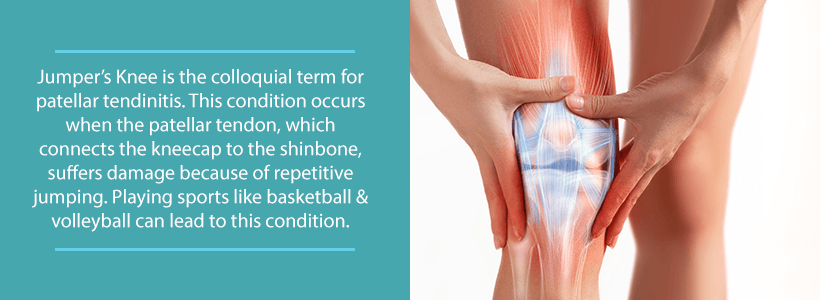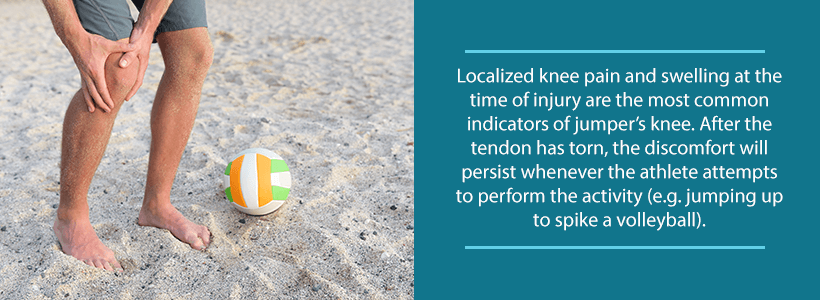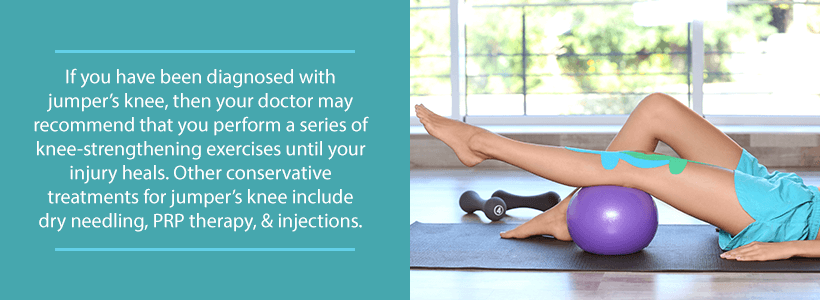What is Facet Nerve Ablation? Those who are seeking degenerative disc disease treatments have probably come across facet nerve ablation in their searches. But, is this an effective method of treating your degenerative disc disease…
Jumper’s knee was a term first coined in 1973 as a layman’s word for insertional tendinopathy. Such an injury describes damage to an athlete’s tendon at the point where it meets the bone. Patellar tendinitis involves the point where the kneecap tendon meets the lower kneecap pole. The condition, more specifically, refers to functional stress overload as a direct result of repetitive jumping.
Jumper’s knee is a common form of tendinopathy among athletes with mature skeletons. In fact, the condition occurs in as many as 20% of all jumping athletes. Both genders are equally affected when it comes to developing jumper’s knee on both sides of the body simultaneously. Although this may be the case, one-sided jumper’s knee is twice as likely to affect males as it will females.

Causes of Jumper’s Knee
Generally speaking, repetitive stress on either the patellar or quadriceps tendon during jumping often leads to this condition. This injury specifically affects athletes, especially those who partake in sports with ample amounts of jumping (e.g. basketball, volleyball, long jumping, etc.) Occasionally, jumper’s knee may occur in soccer players, weight lifters, and cyclists (although this is more unusual).
General risk factors for developing this condition include:
- Gender
- Obesity
- Bow-leggedness
- Knock-kneedness
- Deformities that lead to an increased angle of the knee
- An unusually low or high kneecap
- Having a difference in leg lengths
- Overtraining
- Performing sports on hard surfaces
Factors that influence the condition also include poor flexibility in the quadriceps and hamstrings, vertical jump ability, and the techniques that the athlete uses to jump and land. All of these considerations influence tendon loading.
Naturally, the kneecap tendon has a much greater mechanical load during landing than it does while jumping. This is due to the off-center muscle contraction of the quadriceps. This unusual muscle action, which occurs naturally when we jump, may lead to mechanical overexertion and subsequent injury.
Jumper’s Knee Classification & Symptoms
Although it may somewhat depend on the nature of the case, jumper’s knee is generally categorized into 1 of 4 stages:
- Phase 1 – Pain only occurs after the athlete completes the activity, with no functional impairment during the activity.
- Phase 2 – The athlete experiences pain during and after the stressor activity. Although there is pain during the activity, the athlete should still be able to perform adequately in their sport.
- Phase 3 – Pain persists during and after athletic activity. At this point, it becomes much more difficult for the athlete to perform at a satisfactory level.
- Phase 4 – The tendon has torn and will require surgery to fix.
Jumper’s knee may manifest as either chronic or acute, meaning that the condition may have a sudden onset or it may result from repetitive motions over time. Individuals with the condition may experience one or several of the following symptoms:
- Pain: The main, most obvious symptom. An athlete may experience throbbing pain beneath the kneecap during activities that stress the knee joint. Usually, pain worsens with activity continuation and diminishes with rest. Over time, however, the pain may become constant, even during periods of no activity. Actions such as kicking, running, and bending the knee can all exacerbate the pain associated with the condition.
- Swelling: Jumper’s knee may lead to minor swelling of the knee joint, thereby reducing the athlete’s range of motion.
- Bruising: Discoloration of the knee may be observable in cases of acute jumper’s knee.
- General Discomfort: If the case is bad enough, symptoms may manifest from daily activities such as climbing stairs, bending down, or kicking.
If you suspect you have jumper’s knee, then you should consider resting. Otherwise, the condition will only become progressively worse with time.

Jumper’s Knee Diagnosis
If you suspect that you have a sustained knee injury, then you should always seek medical help. Especially if you are an athlete. For a knee injury, the diagnostic procedure often includes:
- Physical Exam: Your doctor will almost always perform some variation of a physical exam if you walk in with a knee injury. A physical exam is useful for detecting anomalies such as swelling, limited range of motion, bruising, abrasions, and more. Your symptoms will tell your doctor a lot about the nature of your case. Throughout this process, your physician will ask you a series of questions about the causes of your injury, the kind of symptoms you are experiencing, and the intensity of your pain.
- Medical History: Almost any visit to a doctor’s office will involve providing your detailed medical history. Sustained knee injuries are no different in this regard. Your medical history is important to your physician as it will be able to tell him or her whether a pre-existing medical condition has had any bearing on your case.
- Imaging Tests: Once your physician has conducted a physical examination and reviewed your medical history, he or she will then order imaging tests (such as x-rays or MRIs). Whatever avenue your doctor decides to use will help to solidify his or her final diagnosis of your condition.
Treatment for Jumper’s Knee
As with most medical conditions, treatment for jumper’s knee usually breaks down into conservative options or surgical procedures. Usually, your doctor will attempt to exhaust conservative treatments first before considering surgery. But, this obviously depends upon the nature of your case.
If you have an immediate injury that needs attention, then you should consider using NSAIDs and the R.I.C.E method (rest, ice, compression, and elevation). Both of these methods help to reduce pain and swelling around the affected area.
Conservative Treatments
The list of conservative treatments for a knee injury is quite extensive. Your doctor may recommend the following methods:
- Exercise Training: Involves a series of knee-strengthening exercises to alleviate the symptoms of your condition. These techniques are often used in conjunction with bracing to support the knee during the healing process.
- Injection Therapy: Only used for more advanced cases, this involves administering a corticosteroid injection to the athlete to reduce inflammation and accelerate healing.
- Platelet-Rich Plasma Therapy: Involves injecting the patient with their own platelet-rich plasma as a means to accelerate the healing process
- Dry Needling: With this treatment, a needle without a syringe is inserted into the injured area and moved using the guidance of an arthroscopic camera. The goal of this is to break up degenerative structures at the injury site that may be contributing to the patient’s condition.
- Hypothermic Thermotherapy: This treatment uses both a heating and a cooling source to raise the temperature of damaged tissues at the injury site. During this process, the cooling source ensures that the surface level tissues remain cool.
- Extracorporeal Shockwave Treatment: This entails sending electrical impulses into muscle tissue that surrounds the knee bone to deliver force to affected tissues. The force from these waves encourages damaged tissues to heal faster.

Surgical Treatments
The two most common procedures for treating severe cases of jumper’s knee include:
- Arthroscopic Resection of the Inferior Aspect of the Kneebone: Your doctor will employ this method if the inferior aspect of the patella needs to be removed or realigned. This is performed in order to remove unwanted stress on the patellar tendon.
- Arthroscopic Debridement: A small camera and several specialized surgical implements are inserted into the affected site and then used to remove damaged tissue.
Do you believe that you have a knee injury such as patellar tendinitis? If you think you do, then seek out medical consultation as soon as possible. Unfortunately, untreated injuries will only exacerbate over time, so seek help from a board-certified orthopedic specialist. Our team is composed of passionate experts who run an efficient facility with the goal of getting you back to life and enjoying the things you love. Don’t hesitate, contact us today!

